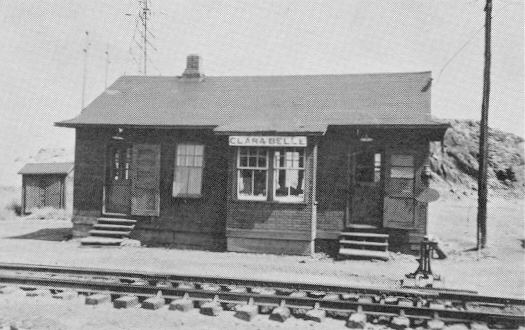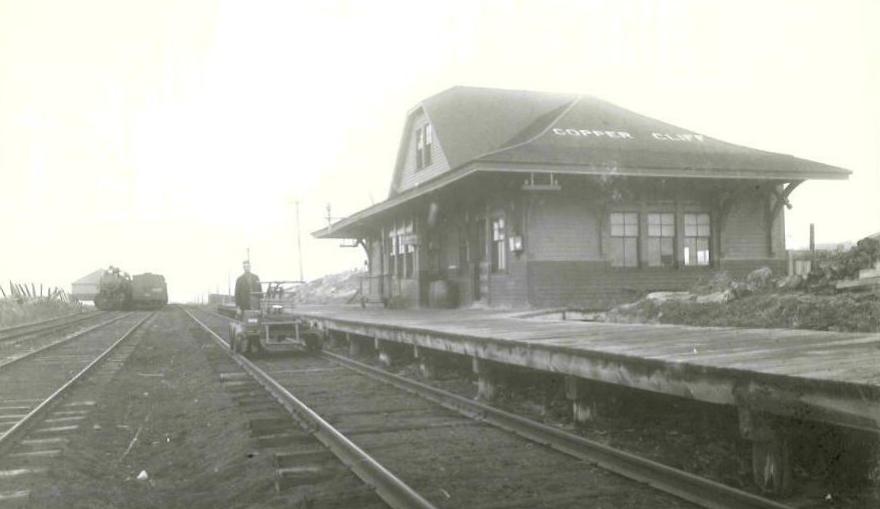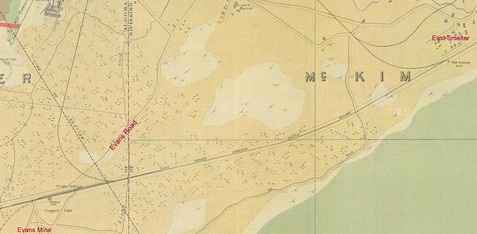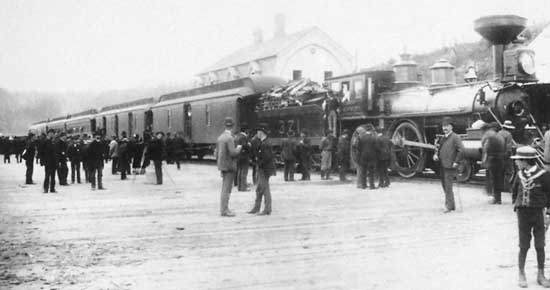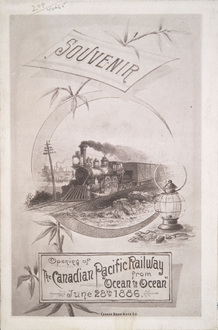Clara Belle StationIn May 1900, the Manitoulin & North Shore Railway chose Little Britain as the location for a small yard and two stall engine house. Construction began from there westward to Clarabelle (Mile 4.8) where it connected with the Canadian Copper Company's railway to their smelter complex at Copper Cliff. In 1911 the railway was renamed the Algoma Eastern Railway. Clara Belle was a way station on the Algoma Eastern Railway.
In June 1916, the Canadian Northern Railways applied to the Dominion Board of Railway Commissioners to construct a railway spur to the Canadian Copper Company Smelter in Copper Cliff, independent of the Algoma Eastern Railway. March of 1930 saw the Algoma Eastern Railway leased to the Canadian Pacific Railway (CPR) for 999 years. Clara Belle became an industrial station. The station north-east of Copper Cliff was known as Clarabelle on CPR system timetables. According to Dale Wilson's Algoma Eastern, one CPR official insisted that this station was actually the remnant of a much larger structure. http://www.trainweb.org/oldtimetrains/sudbury/Algoma_Eastern.htm Old Time Trains Algoma Eastern Railway by Dale Wilson |
J. A. Bergeron worked with the CPR from 1917 to 1953, and for the period 1935 to 1953 was the agent at Clarabelle Station. Prior to 1935 he worked at Levack and Murray Mine stations. Clarabelle, because of the tonnage in and out of Copper Cliff, was known as “the biggest little station in Canada”.
Pasted in Mr. Bergeron's scrapbook is a clipping from the "Bantor Magazine," describing Clara Belle. "Tucked in behind the Inco Smelter at Copper Cliff, a little Station called Clara Belle serves the Canadian National Railway (CNR) and the CPR and the Inco Railway and consists lock stock and barrel of one railway station, a stretch of track and a splendid view of the Inco slag piles. It serves more railway companies than any other station in Northern Ontario.” "It draws more railway revenue per station employee than any other centre in Northern Ontario and probably in Canada.” The Inco Triangle February 1953.
Railway lines funneled into Clarabelle from seven different directions. The stretch of track in front of the station is linked to Creighton, Murray Mine, Sudbury, the CNR main line, Frood, Levack and the Copper Cliff Smelter.
Pasted in Mr. Bergeron's scrapbook is a clipping from the "Bantor Magazine," describing Clara Belle. "Tucked in behind the Inco Smelter at Copper Cliff, a little Station called Clara Belle serves the Canadian National Railway (CNR) and the CPR and the Inco Railway and consists lock stock and barrel of one railway station, a stretch of track and a splendid view of the Inco slag piles. It serves more railway companies than any other station in Northern Ontario.” "It draws more railway revenue per station employee than any other centre in Northern Ontario and probably in Canada.” The Inco Triangle February 1953.
Railway lines funneled into Clarabelle from seven different directions. The stretch of track in front of the station is linked to Creighton, Murray Mine, Sudbury, the CNR main line, Frood, Levack and the Copper Cliff Smelter.
Copper Cliff StationFrom the Geological Map of Copper Cliff Mine and Vicinity by A. P. Coleman, 1903 there is an ‘old station’ located near the ‘now’ Balsam Street entrance to Copper Cliff. The Canadian Pacific Railway (CPR) station was located south-west of the Power Street entrance to Copper Cliff on Evans Road.
|
First Transcontinental TrainFrom John D. Evans Diary of June 29, 1886 “At station in morning for decoration of station. First through train to Pacific passed at 2:10 p.m.” This was the first Canadian Pacific transcontinental passenger train travelling from Montreal. The train arrived at Port Moody, British Columbia on July 4, 1886.
There was an Ottawa House near the CPR station in Copper Cliff in November, 1903. It was run by Mrs. M. J. Kearney. |
|
In 1911 Samuel Henry ‘Harry’ Sunstrum was the CPR Station Agent, and living at the station. He was born February 15, 1885 in Algoma, Ontario. He married Irene May Walsh, June 7, 1907. At the time of his marriage he was the CPR Agent at Victoria Mines.
Acel Hilton Abell was born October 7, 1884 in Aylmer, Ontario. He married Minnie Gertrude Shepherd on November 16, 1905 Elgin County, Ontario. Hilton left the farm to become a telegraph operator, serving for a time as agent for Grand Trunk & Wabash Railway at the Aylmer Station; later for the CPR at Copper Cliff. 1911 Census of Gibson Street West, Parry Sound, Hilton Abell, age 26 was a station agent. He and his wife Gertrude, age 26 were boarders at the home of Catherine Spence. In 1914 J. B Hill was Foreman at the CPR Freight Sheds on Evans Road. He lived at 3 Diorite Street. A. H. Abell was Agent at the Copper Cliff Station, living at 58 Power Street. By 1920 A. H. Abell was Agent at both the Freight Sheds and Station, living at 42 Power Street. In 1930 Hilton and his wife Gertrude were living at 189 Worthington Crescent. In 1927, W. J. Hawkins was the CPR Operator at the Copper Cliff Station. |
